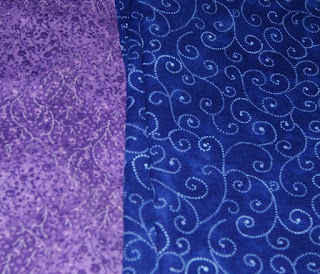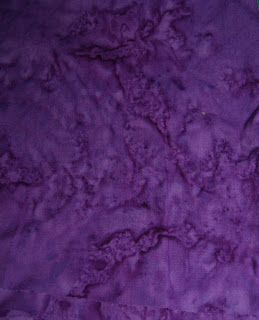Over the past couple of years, there are two new fabrics
that have invaded the 100% cotton fabrics that quilters love so much. Those two fabrics are flannels and
wools.
I was first introduced to flannels about 27 years ago
when I was pregnant with my son. I made
Matt a crib quilt and backed it with flannel.
To say I was not impressed with flannel is a severe understatement. It frayed and did not play well with the
batting. It was a headache to sew with
from beginning to end and I swore I would not spend what precious little
quilting time I had with such an onerous fabric again.
The back of Matt's Baby Quilt
Besides, flannel didn’t even come in pretty colors.
Flash forward ahead to three or so years ago, say, circa
2013. My how things have changed. Bonnie Sullivan came out with a line of
flannels that were brilliantly colored, breath-takingly beautiful, and patterns
to go with them. The little quilt shop I
frequent began to purchase bolts of the tempting fabric and flaunt them in
front of my face.
Then they paired the flannels with wool. It was to-die-for gorgeous.
But still a part of me held back. As beautiful as the fabric was and as
preciously cute as the quilt blocks were, it was, after all, still flannel.
And flannel is stretchy.
And if frays easily.
And it does not wash well.
However, I was comparing the 1988 flannel to the new
lines. Some of those concerns still
held, but now…now there were products and methods to counter any of the
hindrances of working with flannel.
The first issue with flannel has obviously been dealt
with – what they look like. While you
can still get the standard light blues, pinks, soft yellows, and mint greens,
the folks that manufacture flannel have upgraded the choices tremendously. They are patterned in herringbone, tweeds,
plaids, stripes, flowers, and dots.
Quilt panels are also appearing in flannel. One quick glance in quilt catalogs and some
quilt stores (as well as some “big box” stores) dispels the notion that
flannels are dull.
Flannels for my Raspberry Swirl
Now for the stretch issue. That is still true with flannel. It does stretch. Flannel is typically made out of wool, but it
is mixed with cotton and synthetic fibers.
It’s the synthetic fibers that give flannel its stretch. However, there are some suggestions on
handling the flannels that help keep their shape.
First, lightly starch the wrong side of the flannel with
spray starch or Best Press and a hot iron before cutting. The key word here is lightly. The fabric should
not be stiff, but have just enough added body to stabilize it.
Second, be sure to
press and not iron the fabric.
Remember my earlier blog about the difference between pressing and
ironing? Ironing is a back and forth
motion of the iron and pressing is an up and down motion. If the flannel is ironed, that back and forth
motion is sure to stretch the fabric even more.
If you’re putting the iron to your
flannel, be sure press at all times.
Third, if you have to use the exposed bias (as in
half-square triangles), handle those as little as possible and as gently as you
can. And expose that bias at the last
minute to avoid stretching.
As far as the fraying issue goes, flannel is going to
fray far worse than cotton quilting fabric.
And cheap flannel frays the worst. However, if the quilter is prepared
for the fray, then he or she knows there are steps to take to combat it.
Flannel is often used as a background for wool or
flannel applique. If this is the part
flannel is playing in your quilt, then cut the background square at least
¼-inch to a ½- larger than the unfinished
required size. Yes, this is larger than
you cut cotton backgrounds, but again, flannel frays a lot worse than cotton
fabrics. This added width and length
gives you what I call “fray margin.” The
loose threads can easily be trimmed away without messing up your required
unfinished measurements.
If this amount fray margin can’t be achieved, zig zag or
serge the edges of the square. Remember that typical applique patterns require
the quilter to cut the square down a little before piecing the quilt. The zig zag or serged stitches will be cut
away, so no additional bulk with be added to the seams.
There is also a product on the market called Fray
Check. It’s typically available at the
“big box” stores and at some quilt shops.
This product has been on the market for years. I used it back in the 1980’s-1990’s when I
taught French heirloom sewing. I would
coat the end of the ribbons I used in Meg’s dresses so they wouldn’t fray. It has the consistency and look of clear
fingernail polish, but it dries soft.
While it would be costly to coat all of the edges of a flannel quilt in
Fray Check, if there is a spot or two that has some really bad “fray issues,”
it is my go-to choice to deal with it.
Fray Check
While we’re on the subject of applique and flannel, it
should also be remembered that flannel has a very soft hand – that is, it’s a
really soft fabric. It doesn’t have the
stiffness that cotton does when it comes off the bolt. Therefore, don’t wash the flannel before you begin to work with it.
This may go against everything you know about prepping
fabric for quilting, but flannel is a horse of a different color when it comes
to piecing and quilting. Flannel
manufacturers do put a type of sizing on the right side of the flannel before
they ship it out to the wholesale and retail markets. However, that sizing is far less and much
softer than what’s used on cottons. So
it’s not a good idea to wash out what little finish is in the fabric. Plus, the added washing would cause the
fabric to fray even more.
And this, of course, means two things. There is that possibility of the flannel
pieces fading on each other. But again,
this is 2015, and dyes have come such a long way, especially in the flannel
market. When the flannel item is washed,
throw a Color Catcher in the washer and everything will most likely be fine.
Second, this means that when the flannel quilt is washed
and dried, there will be some shrinkage.
And this shrinkage will cause the quilting to “pucker” just a bit and
give the quilted item the look of an “older” quilt.
That soft feel of the flannel may make you a little
hesitant about machine appliqueing with flannel. Don’t be afraid. It machine appliques beautifully. There will be a future blog on this topic that
will go into more detail, but it boils down to a few important things to keep
in mind.
--Use a smaller and tighter zig zag or blanket
stitch. Because flannel frays, that
smaller and tighter stitch keeps the fray factor in check.
--Back flannel with a stabilizer. Because the flannel has such a soft hand,
your sewing machine may not want to move it over the feed dogs evenly with a
small, tight stitch. The result will be
a hole in your flannel. My favorite
product to use as a stabilizer on flannel is Pellon’s Stacy Easy Knit. It irons on and is light and soft. It does not have to be removed prior to
quilting, either. It’s easy to quilt
right through, either on a domestic sewing machine or a long arm.
Pellon's Stacy Easy Knit - you can see how light and soft it is.
Finally, when the quilt square is finished, it’s a good
idea to stay stitch around the block to help the flannel hold its shape and not
fray. And clean your machine when the project is done. Flannel is very, very linty. Your machine will need to be cleaned
thoroughly.
More on flannel (and wools!) in a week or so….until
then,
Love and Stitches,
Sherri
PS -- Always remember that I am not a paid employee of any product company I promote on my website. I mention the product and trade names that I use and pay for myself and know to be of good quality.















